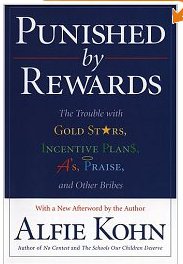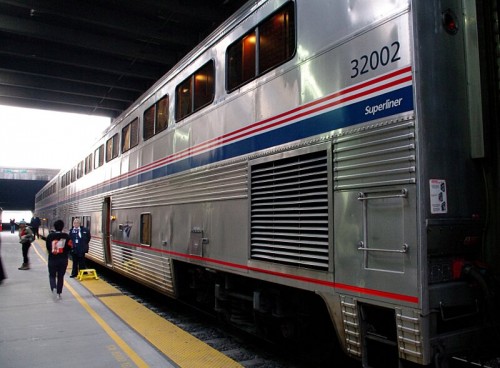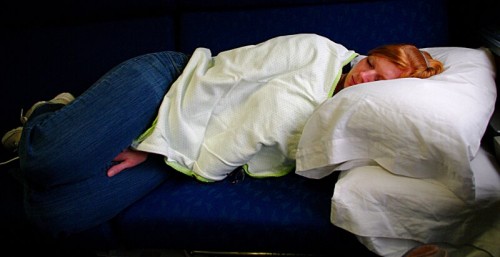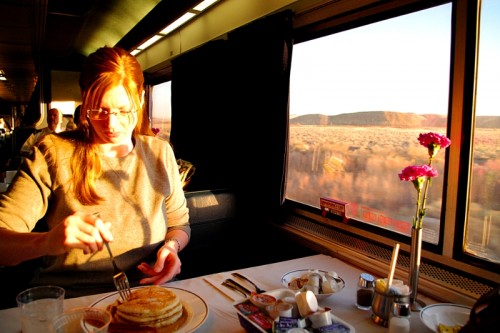We took the train across the country to get to Connecticut for Christmas. We left from Sacramento, switched trains in Chicago, and ended in Springfield, Massachusetts.
Before we get into the story, we'll cut right to the chase: Would we take the train again? Yes. From both of us. That's not to say we didn't have any annoyances, but overall it was a very enjoyable experience.
Personally, one of the best parts was that at no point in time did our belongings get rifled through. We were never patted down, scanned, or otherwise harassed. We made it from California to Connecticut and back and I never even had to get out my driver's license. It was nice.
Also, this is going to be a very picture-heavy post, so be prepared. If you don't care so much for the narrative, I have some general thoughts on riding the train at the very bottom of the post which you still might enjoy.
Anyway, on to the story. We left Sacramento on December 18. We drove up, parked at the station, and waited for our train to arrive. The trip almost failed before it began though because the train was delayed ~20 minutes (which we knew), but we were waiting for an announcement in the station that it had arrived. But for some reason the station agents weren't making their announcements (or the system was broken or something). Anyway, our train had arrived, but we didn't know until an employee heard some of us waiting for the same train talking about what was going on. The employee informed us the train was outside right now! So we hustled it out there and got on with just a couple of minutes to spare.
So we got on the train just fine. We had a private room in the sleeper car which made the journey very pleasant. We had a private bathroom with shower and a sink with a mirror. There's a top bunk that folds down while the bench seat slides down like a futon. Jess' foot is resting on a fold-up jump-seat across from her offering another sitting location. There was a closet with hangers for us to hang our coats and small luggage fit nicely under the seats. There was also a storage ledge above the jump-seat. The room was actually more spacious than I expected it to be. Once you get all your luggage stowed away it's quite comfortable.
This car was a Superliner which has 2 floors and getting up the stairs was a little tricky with all of our luggage, but it's not so big of a deal if you aren't in such a hurry and take a couple of trips.
Our room provided us with a little pamphlet detailing our trip and providing short paragraphs describing the towns we passed through along the way. This provided a nice way of keeping track of our progress and learning a little something about the areas we went through.
The California Zephyr took us up through the Sierra Nevada Mountains and gave us a great view of Donner Lake:
Here's a short video:
I hopped off for a second in Reno in order to get a picture of our car. The dining car was attached directly to our car which made meals really convenient.
From there it was across Nevada and Utah throughout the night. During the night we looked out our window at the stars and at one point I saw a shooting star. That part was very pleasant.
Unfortunately, our first night was not without issue. Apparently, at some point before we got on the heat had been up high and someone messed with the settings, turning the heat to the lowest setting and separately turning off the heating system completely with another switch. So during the night it got cold, very cold. As we passed through Salt Lake City and down through Provo, the temperature in our room dropped down to around 40F. The car attendant was suffering the same conditions and turned the temperature back up, but neglected to notice the other setting change.
The heat came back on while we were off at an early breakfast (the dining car had plenty of heat). Heather didn't seem to mind the cold, she slept great that night.
So we were awake for the last bits of Utah and watched the sunrise as we ate breakfast. Then we watched the scenery as we headed through Colorado and up into the Rocky Mountains:
Here's a longer video of us just cruising along:
We got out to stretch our legs in Fraser, CO, where it was quite cold:
Heather was enjoying herself for most of the trip. This is her with her head thrown back making all sorts of happy noises (though it kind of looks like she's screaming).
Then it was under the Continental Divide via Moffat Tunnel:
Then it was pretty much dark across Nebraska and Iowa. We watched A Muppet Christmas Carol before going to sleep that night. The next day was our last on the California Zephyr. We crossed the Mississippi River and headed in to Chicago.
Jess decided to take a nap that afternoon:
We had a 6-hour layover in Chicago which we spent hanging out in the Metropolitan Lounge (for us hoity-toity first-class passengers). Despite Heather getting too warm while we made our way from the train to the lounge (and thus screaming) it was nice. Then it was just a matter of trying to ignore the old people criticizing our parenting because it had been just so obvious to them what was wrong with her each time she was upset all the way from Sacramento to Chicago and we were just such terrible parents. (They weren't saying this to us, but they were talking plenty loud enough for us to hear 30 feet away.)
Once we were boarded onto our train (the Lake Shore Limited) we went to bed. I woke up during one of our stops and saw this nice little display at the station:
Unfortunately for us, the Lake Shore Limited splits into 2 in Albany and half of it goes to New York City and the other half heads to Boston. The dining car went to NYC, which meant it was on the complete opposite end of the train from our sleeper car. So when we ate meals we had to trudge through 6 coach cars and the snack car. And, perhaps you haven't noticed, but train cars are pretty long (these were ~85'4"). It was around a tenth of a mile from our room to the dining car (1-2 city blocks, depending on the city).
This car was a Viewliner car which only has one floor (East Coast tunnels are shorter), but the car is still fairly tall which meant we had a higher ceiling in our room and there was lots of luggage space because we had shelving above the bathroom and over the hallway. Overall the room is basically the same.
The next day was our last for our train adventure and Heather spent some time kicking a pretzel bag, which she was really enjoying.
Here's a picture of Jess eating breakfast. I actually took it on our way back to California because I forgot to take any pictures of the dining car on the way to Connecticut. Watching the sunrise while eating a stack of pancakes while cruising across the country at 80mph isn't a terrible way to travel. All of our meals were included with the private sleeping room accommodations. So, at each meal time we'd just head into the dining car and order whatever we wanted. The food was pretty decent, on par with your average sit-down-and-eat restaurant.
We arrived in Springfield and my parents and Mollie picked us up and drove us back home to Connecticut.
-----------
The Return Trip
I'm not going to write a separate post for the trip back or include a bunch of pictures. So I'll just summarize it quickly here:
We got back on the Lake Shore Limited in Springfield on Jan 1. During that ride we had some snow across Ohio and Indiana. This was interesting because in the vestibules between cars it was piling up in places and coating things in ice. This made that 1/10 of a mile trek to and from the dining car particularly interesting. We called it the trek through the steerage rabble and the arctic tundra.
The Lake Shore Limited took us to Chicago where we had a 4-hour layover. I discovered via the Internet that there was a Panda Express about a block away so I walked over there to buy us lunch. It was cold out. Colder than it had been the entire time we were in Connecticut.
We boarded the California Zephyr again for our last train ride of the trip. Unfortunately, our car was hot. Each room has an individual thermostat which allows you to set your room to be some amount warmer or cooler than the car temperature. We had our thermostat all the way down but we were still too warm. So we asked our car attendant to turn down the car's thermostat which helped, but it was still too warm.
Jess and I were able to deal with being too warm just fine, but Heather was not as tolerant. Once she gets too hot she screams and screams until she cools down again (at least we believe that was what was happening). So she spent most of that trip in her diaper trying to stay cool, which mostly worked. We were able to get the attendant to turn down the thermostat 1 or 2 more times I think and by the time we were getting in to California the temperature was fine.
We're not sure what the deal was. The rest of the car didn't seem to be particularly warm, but our room sure was.
Also, as we were making our way across Iowa the horn on our engine failed. You're not really allowed to drive a train without a functioning horn. With no horn the train has to stop at each grade crossing and wait for a conductor to get out and verify that the road is safe before continuing on. This is a real problem.
We only did that 2 or 3 times while they worked on a better solution. They eventually arranged for a freight engine to hook up with us and solve our horn problem. The issue there, though, is that the freight engine is only allowed to go 70mph (whereas the passenger engines usually travel at ~80mph).
So the train was getting further and further behind schedule. It didn't really matter to us, but it would have been a real annoyance if your stop ended up being in the middle of the night instead of the evening because of it. When we finally reached Denver they switched out the freight engine and malfunctioning engine for a working passenger engine. By the time we left Denver we were 5 hours behind schedule. But we managed to make up 1.5 hours across Utah and Nevada so we arrived in Sacramento only 3.5 hours later than we would have.
We got back in the early evening on Jan 4 and packed our vast quantities of stuff into the car and drove home (We went with 1 checked bag and returned with 5, because I filled a few with some of my stuff still kicking around in CT. We also came back with a 3-foot tall kangaroo stuffed animal which took its own duffel bag, but arrived safely.). While the train ride was a fun adventure we were glad to be home. I don't think either of us quite appreciated the space in our small little apartment until we came back to it after so many days on the train.
----------------
General Thoughts on Riding the Train
Don't be in a hurry:
Freight traffic gets priority because the freight companies actually own the tracks that Amtrak operates on. So there will be delays that Amtrak has no control over. However, the schedule has a fair bit of room for slip, which means it is often possible to make up a good chunk of time if you fall behind.
Be willing and able to MacGyver yourself solutions to little annoyances:
Our first room had a cabinet door that would swing open with the movement of the train. So we folded up a tissue and stuck it in the door jamb which kept the door in place.
The air on the train was extremely dry. After showering we would leave the bathroom door open to dry out the bathroom and moisten up our air. We eventually started wetting our towels and hanging them from the top bunk which actually made quite a difference in the moisture content of the air.
One of our faucet handles rattled, so we placed a washcloth against it to keep it silent. A part on the top bunk was rattling at some point and, again, a washcloth slid between it and the mattress helped keep it quiet.
Bring small carry-on luggage:
The sleeper rooms have several places to stash small pieces of luggage, but not larger pieces of luggage (you can leave them in a luggage area outside your room, elsewhere in the car, if you want). So rather than bringing one large piece, it's much more convenient to bring 2 or 3 small items that can be stashed away easily.
 In Part 1 I discussed Kohn's argument for rewards/punishments creating self-centered individuals and how urging a focus on rewards/punishments can have unintended consequences by encouraging short-cutting the desired behavior in order to satisfy the requirements of receiving the reward or avoiding the punishment.
In Part 1 I discussed Kohn's argument for rewards/punishments creating self-centered individuals and how urging a focus on rewards/punishments can have unintended consequences by encouraging short-cutting the desired behavior in order to satisfy the requirements of receiving the reward or avoiding the punishment.














